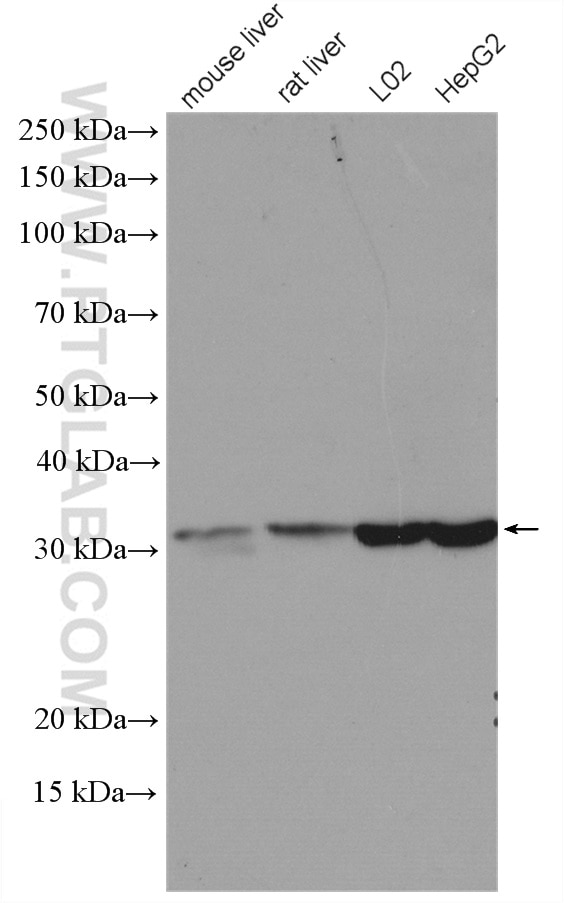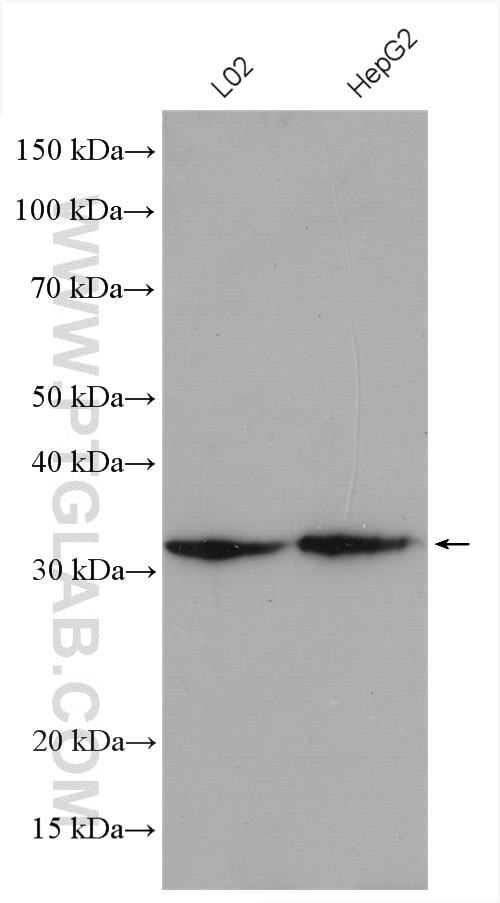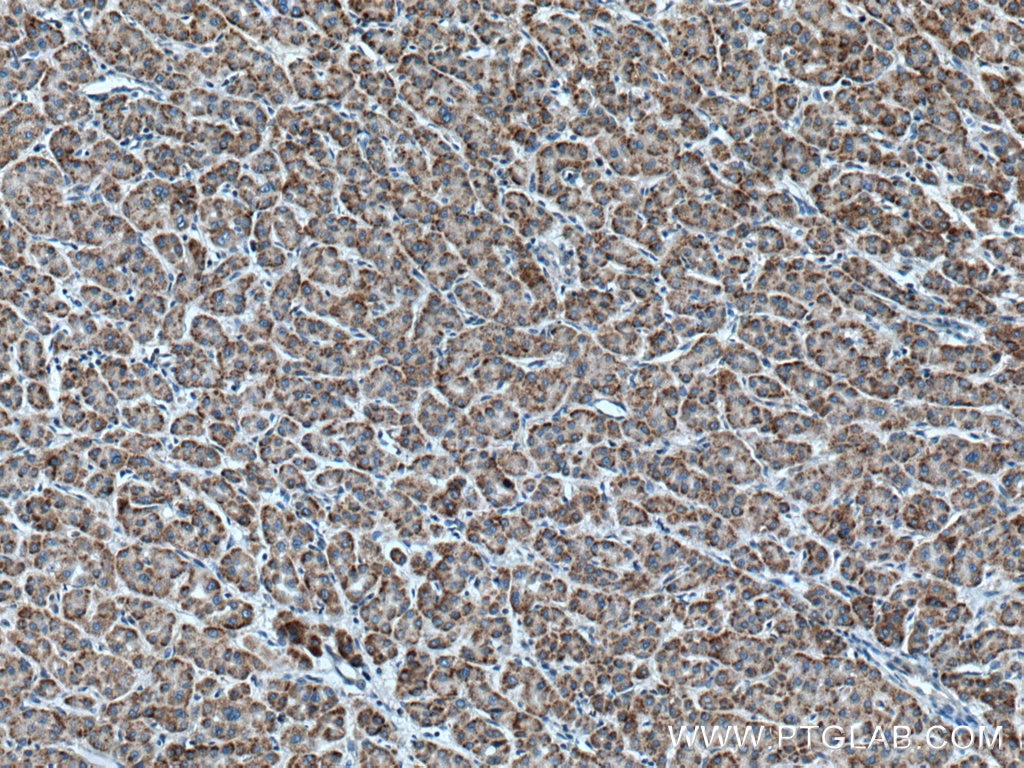- Phare
- Validé par KD/KO
Anticorps Polyclonal de lapin anti-RACK1; GNB2L1
RACK1; GNB2L1 Polyclonal Antibody for WB, IHC, ELISA
Hôte / Isotype
Lapin / IgG
Réactivité testée
Humain, rat, souris et plus (2)
Applications
WB, IHC, IF, IP, CoIP, RIP, ELISA
Conjugaison
Non conjugué
N° de cat : 27592-1-AP
Synonymes
Galerie de données de validation
Applications testées
| Résultats positifs en WB | tissu hépatique de souris, cellules HepG2, cellules L02, tissu hépatique de rat |
| Résultats positifs en IHC | tissu de cancer du foie humain, tissu de cancer de l'estomac humain il est suggéré de démasquer l'antigène avec un tampon de TE buffer pH 9.0; (*) À défaut, 'le démasquage de l'antigène peut être 'effectué avec un tampon citrate pH 6,0. |
Dilution recommandée
| Application | Dilution |
|---|---|
| Western Blot (WB) | WB : 1:500-1:3000 |
| Immunohistochimie (IHC) | IHC : 1:400-1:1600 |
| It is recommended that this reagent should be titrated in each testing system to obtain optimal results. | |
| Sample-dependent, check data in validation data gallery | |
Informations sur le produit
27592-1-AP cible RACK1; GNB2L1 dans les applications de WB, IHC, IF, IP, CoIP, RIP, ELISA et montre une réactivité avec des échantillons Humain, rat, souris
| Réactivité | Humain, rat, souris |
| Réactivité citée | Humain, porc, singe, souris |
| Hôte / Isotype | Lapin / IgG |
| Clonalité | Polyclonal |
| Type | Anticorps |
| Immunogène | RACK1; GNB2L1 Protéine recombinante Ag26708 |
| Nom complet | guanine nucleotide binding protein (G protein), beta polypeptide 2-like 1 |
| Masse moléculaire calculée | 36 kDa |
| Poids moléculaire observé | 31 kDa |
| Numéro d’acquisition GenBank | BC019093 |
| Symbole du gène | RACK1 |
| Identification du gène (NCBI) | 10399 |
| Conjugaison | Non conjugué |
| Forme | Liquide |
| Méthode de purification | Purification par affinité contre l'antigène |
| Tampon de stockage | PBS with 0.02% sodium azide and 50% glycerol |
| Conditions de stockage | Stocker à -20°C. Stable pendant un an après l'expédition. L'aliquotage n'est pas nécessaire pour le stockage à -20oC Les 20ul contiennent 0,1% de BSA. |
Informations générales
Members of the protein kinase C (PKC) family play a key regulatory role in a variety of cellular functions, including cell growth and differentiation, gene expression, hormone secretion and membrane function. RACK1 (receptor for activated protein kinase C 1), encoded by GNB2L1 gene, is a 317 amino acid guanine nucleotide-binding protein subunit beta-2-like 1 protein which is involved in the recruitment, assembly and/or regulation of a variety of signaling molecules, it contains 7 WD-repeats and is implicated in various protein interaction activities. RACK1 is a component of the 40S ribosomal subunit involved in translational repression. Recent finding suggests that RACK1 may be a new promising diagnosis biomarker and therapeutic target for non-small-cell lung cancer (NSCLC).
Protocole
| Product Specific Protocols | |
|---|---|
| WB protocol for RACK1; GNB2L1 antibody 27592-1-AP | Download protocol |
| IHC protocol for RACK1; GNB2L1 antibody 27592-1-AP | Download protocol |
| Standard Protocols | |
|---|---|
| Click here to view our Standard Protocols |
Publications
| Species | Application | Title |
|---|---|---|
J Clin Invest CAP2 promotes gastric cancer metastasis by mediating the interaction between tumor cells and tumor-associated macrophages | ||
Cells Modification of RNF183 via m6A Methylation Mediates Podocyte Dysfunction in Diabetic Nephropathy by Regulating PKM2 Ubiquitination and Degradation | ||
Mol Med LRP11 facilitates lipid metabolism and malignancy in hepatocellular carcinoma by stabilizing RACK1 through USP5 regulation | ||
J Virol The matrix protein of respiratory syncytial virus suppresses interferon signaling via RACK1 association | ||
Cancers (Basel) RACK1 Promotes Meningioma Progression by Activation of NF-κB Pathway via Preventing CSNK2B from Ubiquitination Degradation | ||
Virology RACK1 promotes porcine reproductive and respiratory syndrome virus infection in Marc-145 cells through ERK1/2 activation
|







